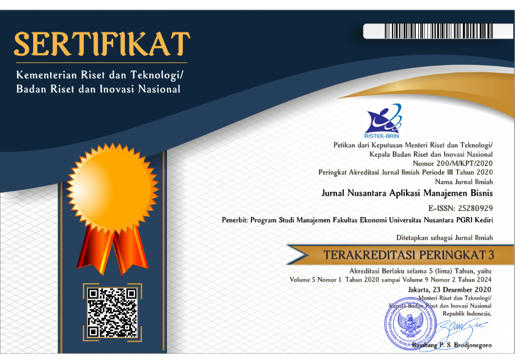Peran Job Satisfaction dalam Memediasi Hubungan Strategic flexibility, Behavioural Innovation, dan Employee engagement dengan Employee Performance
DOI:
https://doi.org/10.29407/nusamba.v10i1.22305Keywords:
strategic flexibility, behaviour innovation, Employee engagement, Job satisfaction, employee performanceAbstract
Research aim: This study examines the relationships between strategic flexibility, behaviour innovation, Employee engagement, Job satisfaction, and employee Performance within SMES in the clothing sector in East Java. It also provides empirical evidence of causal interactions among these variables.
Method: An explanatory approach was employed with a sample of 160 employees from SMES in Bangkalan, Sidoarjo, Tulungagung, and Mojokerto, selected via cluster sampling. Data were collected using a Likert-scale questionnaire and analysed using PLS-SEM with Smartpls 4.
Research Finding: The findings show that strategic flexibility positively and significantly influences employee Performance and Job satisfaction. Behaviour innovation negatively impacts employee Performance but positively affects Job satisfaction. Employee engagement positively influences employee Performance but is not significant for Job satisfaction. Job satisfaction partially mediates the relationship between strategic flexibility and employee Performance and fully mediates the relationship between behaviour innovation and employee Performance.
Theoretical contribution: This study challenges existing assumptions about the link between Employee engagement and Job satisfaction, expanding understanding in the context of SMES.
Practical implication: The findings suggest that SME managers should enhance strategic flexibility and focus on Job satisfaction to improve employee Performance while carefully managing behaviour innovation.
Research Limitations: This study has several limitations. First, the study was only conducted on MSMES in the clothing sector in East Java. Second, the data collection method used a Likert-scale questionnaire. Third, the quantitative approach with PLS-SEM provides an understanding of causal relationships but does not explore other factors that may play a role.
Downloads
References
[1] Herrera MEB. Creating competitive advantage by institutionalizing corporate social innovation. J Bus Res 2015;68:1468–74. https://doi.org/10.1016/j.jbusres.2015.01.036.
[2] Brewster C, Gooderham PN, Mayrhofer W. Human resource management: the promise, the performance, the consequences. J Organ Eff 2016;3:181–90. https://doi.org/10.1108/JOEPP-03-2016-0024.
[3] Sumiati S. Peran Lingkungan Internal Dan Fleksibilitas Strategi Untuk Meningkatkan Inovasi Usaha Mikro, Kecil Dan Menengah. Mix J Ilm Manaj 2018;8:695. https://doi.org/10.22441/mix.2018.v8i3.015.
[4] Thomas EF. Platform-based product design and environmental turbulence: The mediating role of strategic flexibility. Eur J Innov Manag 2014;17:107–24. https://doi.org/10.1108/EJIM-06-2013-0055.
[5] Origo F, Pagani L. Workplace flexibility and Job satisfaction: some evidence from Europe. Int J Manpow 2008;29:539–66. https://doi.org/10.1108/01437720810904211.
[6] Harter JK, Schmidt FL, Hayes TL. Business-unit-level relationship between employee satisfaction, Employee engagement, and business outcomes: A meta-analysis. J Appl Psychol 2002;87:268–79. https://doi.org/10.1037/0021-9010.87.2.268.
[7] Hair JF, Babin BJ, Black WC, Anderson RE. Multivariate Data Analysis. Cengage; 2019.
[8] Fornell, C., & Larcker DF. Evaluating structural equation models with unobservable variables and measurement error. J Mark Res This 2016;18:39–50.
[9] Henseler J, Ringle CM, Sarstedt M. A new criterion for assessing discriminant validity in variance-based structural equation modeling. J Acad Mark Sci 2015;43:115–35. https://doi.org/10.1007/s11747-014-0403-8.
[10] Bentler PM, Hu L. Fit indices in covariance structure modeling: Sensitivity to underparameterized model misspecification. Psychol Methods 1998;3:424–53.
[11] Kelliher C, Anderson D. For better or for worse? An analysis of how flexible working practices influence employees’ perceptions of job quality. vol. 19. 2008. https://doi.org/10.1080/09585190801895502.
[12] Altindag EA, Siller F. Effects of Flexible Working Method on Employee performance: An Empirical Study in Turkey. Bus Econ J 2014;05. https://doi.org/10.4172/2151-6219.1000104.
[13] Nadkarni S, Herrmann P. CEO personality, strategic flexibility, and firm performance. Acad Manag J 2010;53:1050–73.
[14] McNall LA, Masuda AD, Nicklin JM. Flexible work arrangements, Job satisfaction, and turnover intentions: The mediating role of work-to-family enrichment. J Psychol Interdiscip Appl 2009;144:61–81. https://doi.org/10.1080/00223980903356073.
[15] Sendow GM, Dotulong LOH, Pritama BS. Pengaruh Human Relation, Fasilitas dan Iklim Organisasi terhadap Semangat Kerja Pegawai Kejaksaan Negeri Manado. J EMBA J Ris Ekon Manajemen, Bisnis Dan Akunt 2019;7:4898–906.
[16] Cottam A, Ensor J, Band C. A benchmark study of strategic commitment to innovation. Eur J Innov Manag 2001;4:88–94. https://doi.org/10.1108/14601060110390594.
[17] Kusuma A, Purwanto H, Utama P. Pengaruh Inovasi Terhadap Kinerja Karyawan Dengan Self Efficacy Sebagai Moderasi. J Ekon Dan Bisnis Islam 2021;23:302–9.
[18] Back Y, Parboteeah KP, Nam D. Innovation in Emerging Markets: The Role of Consulting Firms. Acad Manag Proc 2012;2012:15972. https://doi.org/10.5465/ambpp.2012.15972abstract.
[19] Bergman JP, Jantunen A, Tarkiainen A. Managerial cognition and dominant logic in innovation management: Empirical study in media industry. Int J Bus Innov Res 2015;9:253–71. https://doi.org/10.1504/IJBIR.2015.069136.
[20] Marín-Idárraga DA, Cuartas-Marín JC. Relationship between innovation and performance: Impact of competitive intensity and the organizational slack. RAE Rev Adm Empres 2019;59:95–107. https://doi.org/10.1590/S0034-759020190203.
[21] Pang H, Zhang K. Determining influence of service quality on user identification, belongingness, and satisfaction on mobile social media: Insight from emotional attachment perspective. J Retail Consum Serv 2024;77:103688.
[22] Yuen KF, Loh HS, Zhou Q, Wong YD. Determinants of Job satisfaction and performance of seafarers. Transp Res Part A Policy Pract 2018;110:1–12. https://doi.org/10.1016/j.tra.2018.02.006.
[23] Bashor C, Purnama C. Factors Affecting Performance Manager and Its Impact on Competitive Advantage: Studies Small Medium Enterprises (SMEs) in The Shoes Industry Mojokerto East Java Province. Mediterr J Soc Sci 2017;8:153–62. https://doi.org/10.1515/mjss-2017-0014.
[24] Kortmann S, Gelhard C, Zimmermann C, Piller FT. Linking strategic flexibility and operational efficiency: The mediating role of ambidextrous operational capabilities. J Oper Manag 2014;32:475–90. https://doi.org/10.1016/j.jom.2014.09.007.
[25] Brozovic D. Strategic flexibility: A Review of the Literature. Int J Manag Rev 2018;20:3–31. https://doi.org/10.1111/ijmr.12111.
[26] Beraha A, Bingol D, Ozkan-Canbolat E, Szczygiel N. The effect of strategic flexibility configurations on product innovation. Eur J Manag Bus Econ 2018;27:129–40. https://doi.org/10.1108/ejmbe-02-2018-0028.
[27] Schneider S, Spieth P. Business model innovation and strategic flexibility: Insights from an experimental research design. Int J Innov Manag 2014;18:1–21. https://doi.org/10.1142/S136391961440009X.
[28] Feeny S, Rogers M. Innovation and performance: Benchmarking Australian firms. Aust Econ Rev 2003;36:253–64. https://doi.org/10.1111/1467-8462.00285.
[29] Jaskyte K. Predictors of Administrative and Technological Innovations in Nonprofit Organizations. Public Adm Rev 2011;71:77–86. https://doi.org/10.1111/j.1540-6210.2010.02308.x.
[30] Acar OA, Tuncdogan A, van Knippenberg D, Lakhani KR. Collective Creativity and Innovation: An Interdisciplinary Review, Integration, and Research Agenda. vol. 50. 2024. https://doi.org/10.1177/01492063231212416.
[31] Al-Hakim LA, Hassan S. Core requirements of knowledge management implementation, innovation and organizational performance. J Bus Econ Manag 2016;17:109–24. https://doi.org/10.3846/16111699.2012.720597.
[32] Prajogo DI. The strategic fit between innovation strategies and business environment in delivering business performance. Int J Prod Econ 2016;171:241–9. https://doi.org/10.1016/j.ijpe.2015.07.037.
[33] Graese A, Lemmond D, Boult TE. The Bachelor of InnovationTM: A Student’s Perspective. Int Conf Innov Entrep 2018:151-157,XIII.
[34] Damanpour F. Organizational Innovation: A Meta-Analysis of Effects of Determinants and M oderators. Organ Innov 2018:127–62. https://doi.org/10.4324/9780429449482-8.
[35] Hasibuan FU, Wahyuni R. Pengaruh Pengetahuan Masyarakat dan Minat Penerapan Nilai Islam Terhadap Keputusan Menggunakan Tabungan Perbankan Syariah (Studi Kasus Masyarakat Kota Langsa). J Ilm Ekon Islam 2020;6:22–33.
[36] Robbins S, Judge TA, Millett B, Boyle M. Organisational Behaviour. Pearson Higher Education AU; 2013.
[37] Luthans F, Avolio BJ, Avey JB, Norman SM. DigitalCommons @ University of Nebraska - Lincoln Positive Psychological Capital : Measurement and Relationship with Performance and Satisfaction Positive Psychological Capital : Measurement and Relationship with Performance and Satisfaction. Pers Psychol 2007;60:541–72.
[38] Jodie Firjatullah, Christian Wiradendi Wolor, Marsofiyati Marsofiyati. Pengaruh Lingkungan Kerja, Budaya Kerja, Dan Beban Kerja Terhadap Kinerja Karyawan. J Manuhara Pus Penelit Ilmu Manaj Dan Bisnis 2023;2:01–10. https://doi.org/10.61132/manuhara.v2i1.426.
[39] Robbins SP. Judge. TA (2013). Organizational behavior (Vol. 4) n.d.
[40] Ansori, Manual U, Brämswig K, Ploner F, Martel A, Bauernhofer T, et al. No 主観的健康感を中心とした在宅高齢者における 健康関連指標に関する共分散構造分析Title. Science (80- ) 2022;7:1–8.
[41] Katili PB, Wibowo W, Akbar M. The Effects of Leaderships Styles, Work-Life Balance, and Employee engagement on Employee performance. Quant Econ Manag Stud 2021;2:199–205. https://doi.org/10.35877/454ri.qems319.
[42] Frese M, Krauss SI, Keith N, Escher S, Grabarkiewicz R, Luneng ST, et al. Business Owners’ Action Planning and Its Relationship to Business Success in Three African Countries. J Appl Psychol 2007;92:1481–98. https://doi.org/10.1037/0021-9010.92.6.1481.
[43] Magnier EA, Schlafly EF, Finkbeiner DP, Tonry JL, Goldman B, Röser S, et al. Pan-STARRS Photometric and Astrometric Calibration. Astrophys J Suppl Ser 2020;251:6. https://doi.org/10.3847/1538-4365/abb82a.
[44] Schein EH. Organizational culture. vol. 45. American Psychological Association; 1990.
[45] Costa E, Piazza V, Lavorano S, Faimali M, Garaventa F, Gambardella C. Trophic Transfer of Microplastics From Copepods to Jellyfish in the Marine Environment. Front Environ Sci 2020;8:1–7. https://doi.org/10.3389/fenvs.2020.571732.
[46] Purnama C. The Strategic Experiential Models and Providers in Improving Customer Satisfaction and Loyalty (Study Beverage Bottle Ready to Serve Tea Sosro). Int J Manag Sci 2015;5:54–67.
Downloads
Published
Issue
Section
License
Copyright (c) 2025 Chamdan Purnama, Mirhamida Rahmah , Dinda Fatmah, Syaiful Hasani , Yusriyah Rahmah, Zakiyah Zulfa Rahmah, Sugeng Mulyono, Chairul Anam

This work is licensed under a Creative Commons Attribution-ShareAlike 4.0 International License.
Authors who publish with this journal agree to the following terms:
- Copyright on any article is retained by the author(s).
- The author grants the journal, the right of first publication with the work simultaneously licensed under a Creative Commons Attribution License that allows others to share the work with an acknowledgment of the work’s authorship and initial publication in this journal.
- Authors are able to enter into separate, additional contractual arrangements for the non-exclusive distribution of the journal’s published version of the work (e.g., post it to an institutional repository or publish it in a book), with an acknowledgment of its initial publication in this journal.
- Authors are permitted and encouraged to post their work online (e.g., in institutional repositories or on their website) prior to and during the submission process, as it can lead to productive exchanges, as well as earlier and greater citation of published work.
- The article and any associated published material is distributed under the Creative Commons Attribution-ShareAlike 4.0 International License












